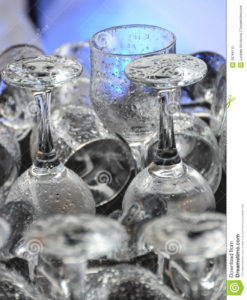Dishware Still Wet After Drying in Dishwasher
**NOTICE**
Due to the danger and complexity of electronic equipment repair, the following technical tip is intended for professional reference only. Please refer to manufacturer’s recommendations as Encompass does not guarantee the accuracy, reliability or safety of this information.
When properly functioning and using a heated dry cycle, your dishes should come out of the dishwasher spotless and dry enough to put away. There’s nothing more frustrating than water droplets dripping from newly-cleaned dishware. If this is happening, here are some common causes to check:
Dishwasher Out of Rinse Aid
Lack of rinse aid is the most probable reason for dishes to come out wet, so check this first. Rinse aid is a solution that is added with the rinse water. It helps water slide off dishware more easily. By the time the dry cycle begins, there should be less moisture on the dishes and cutlery. Rinse aid helps dry faster and remove water spots, so it’s not just a gimmick product. Without rinse aid, the heated dry cycle typically is not going to be enough to remove all the water droplets.
 However, if you’ve never used rinse aid and previously dried dishes are coming out wet, you’ll need to investigate other potential reasons.
However, if you’ve never used rinse aid and previously dried dishes are coming out wet, you’ll need to investigate other potential reasons.
Dishwasher Overloaded
Correctly loading a dishwasher can be a true art form and lesson in organization. But when you try to cram in too many pots, pans and glassware, water can get trapped with no place to drain and heated drying will be less effective — not to mention dishes won’t get fully clean. Consider doing two separate loads or wash dishes by hand instead of overloading the machine.
Heated Dry Malfunctioning
Dishwashers have a variety of drying functions: heated dry, sanitize (high heat kills germs as well as dries dishes) or night dry (heat dries lingering condensation periodically through the wash). Regardless of which you use, they all require a working heating element. This heating element, which also heats water to the proper temperature, creates heat to dry your dishes. If it is not functioning properly, dishes will come out wet. Plus, because water is not getting heated, dishes will likely not come out as clean as normal.
The easiest way to determine if a heating element is faulty is to open the dishwasher immediately after the dry cycle ends. Dishes should be warm to the touch. If they are cold and wet, the heating element has failed. Fortunately, replacing a heating element is a very simple repair.
Faulty Vent Motor or Fan
If dishes are warm after the dry cycle, inspect the vent and motor in the door of the dishwasher. These components push out the hot, moist air circulating during drying. If the fan or motor have failed, the moist air will still vent, but not as efficiently. As such, moist air can become trapped inside and settle back on the dishes.
Visit Fred’s Appliance Academy to learn more about the training provided in appliance repair.
Special thanks to Fred’s Appliance Academy for this helpful tip!

Want more tips? Click here to see all electronics and appliance tips!


